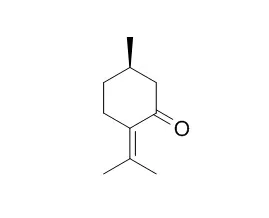| In vivo: |
| Biol Pharm Bull. 2014;37(5):771-8. | | The aversive, anxiolytic-like, and verapamil-sensitive psychostimulant effects of pulegone.[Pubmed: 24790000] |
METHODS AND RESULTS:
We investigated the psychostimulant, rewarding, and anxiolytic-like effects of Pulegone. Possible interactions between Pulegone and menthol concerning their psychostimulant effect were also analyzed. General mouse activity after Pulegone treatment, and the interacitons between Pulegone and menthol, were determined in the open field. The anxiolytic-like activity, motor coordination and strength force were evaluated using the elevated plus maze (EPM), rotarod test and grasping test, respectively. The motivational properties of Pulegone were evaluated by pairing the drug effects on the mice with the least preferred compartment (previously determined) of a conditioned place preference (CPP) apparatus. Pulegone increased mouse locomotor activity and immobilization time. Verapamil, but not diltiazem, haloperidol or picrotoxin, decreased the psychostimulation induced by Pulegone. Pulegone also decreased grooming and rearing behaviors and caused motor incoordination and weakness at high doses. Pulegone increased the time spent by mice in the open arms of the EPM, and flumazenil pre-treatment did not alter this effect. Pulegone either produced no CPP or induced conditioned place aversion. The changes in mouse ambulatory activity caused by the association of Pulegone with menthol were either lower than those predicted by the theoretical curve or not different from the predicted values.
CONCLUSIONS:
Therefore, Pulegone induces a verapamil-sensitive psychostimulant effect that appears to independ on the opening of L-type calcium channels. Pulegone has negative reinforcing properties and seems to possess anxiolytic-like actions unrelated to the benzodiazepine site of the γ-aminobutyric acid type A (GABAA) receptor. Finally, Pulegone might act in an addictive or synergic way with menthol. | | Biochem Pharmacol . 2018 May;151:89-95. | | Involvement of nociceptive transient receptor potential channels in repellent action of pulegone[Pubmed: 29501584] | | Abstract
Pulegone, one of avian repellents, is used to prevent the economic loss caused by birds. Chemical repellents often evoke unpleasant sensations and sensory irritation resulting in avoidance under some circumstances. It is recognized that some TRP channels expressing sensory neurons are related to nociception. Here we determined the molecular mechanisms of the repellent action of Pulegone using isolated chicken sensory neurons and heterologous expression system. Pulegone increased the intracellular Ca2+ concentration ([Ca2+]i) in chicken sensory neurons. There were two types of neurons exhibiting different sensitivity to Pulegone. One was responded to it at low concentrations and the other at high concentrations. Pharmacological analyses revealed that the former was predominantly mediated by TRP melastatin 8 (TRPM8), and the latter by both TRP ankyrin 1 (TRPA1) and TRPM8. An activation of both channels by Pulegone was also determined using heterologously expression system. At high concentrations, Pulegone suppressed chicken TRPM8 but not chicken TRPA1. The intraplantar injection of Pulegone in chicks caused pain-related behaviors that were attenuated by TRPA1 antagonist. These results indicate that Pulegone stimulates both TRPM8 and TRPA1 channel in chicken sensory neurons and suppresses the former but not the latter at high concentrations. Together, these data suggest that the molecular target for the repellent action of Pulegone in avian species is nociceptive TRPA1.
Keywords: AITC (PubChem CID: 5971); AMTB (PubChem CID: 16095383); HC-030031 (PubChem CID: 1150897); Intracellular Ca(2+) increase; Ion channels; Pulegone (PubChem CID: 442495); Repellent; Sensory neuron; TRP channel. |
|






 Cell. 2018 Jan 11;172(1-2):249-261.e12. doi: 10.1016/j.cell.2017.12.019.IF=36.216(2019)
Cell. 2018 Jan 11;172(1-2):249-261.e12. doi: 10.1016/j.cell.2017.12.019.IF=36.216(2019) Cell Metab. 2020 Mar 3;31(3):534-548.e5. doi: 10.1016/j.cmet.2020.01.002.IF=22.415(2019)
Cell Metab. 2020 Mar 3;31(3):534-548.e5. doi: 10.1016/j.cmet.2020.01.002.IF=22.415(2019) Mol Cell. 2017 Nov 16;68(4):673-685.e6. doi: 10.1016/j.molcel.2017.10.022.IF=14.548(2019)
Mol Cell. 2017 Nov 16;68(4):673-685.e6. doi: 10.1016/j.molcel.2017.10.022.IF=14.548(2019)